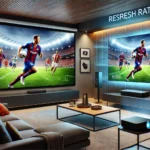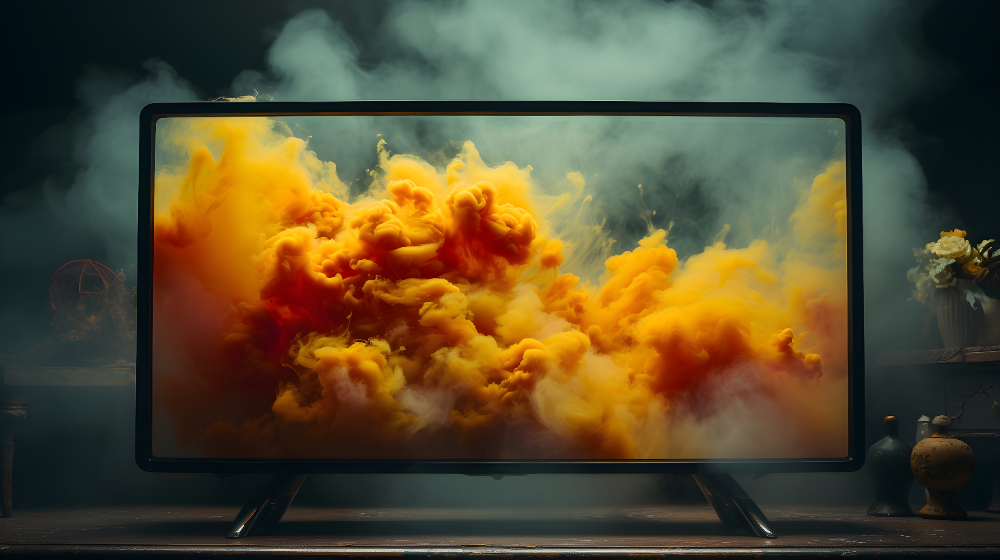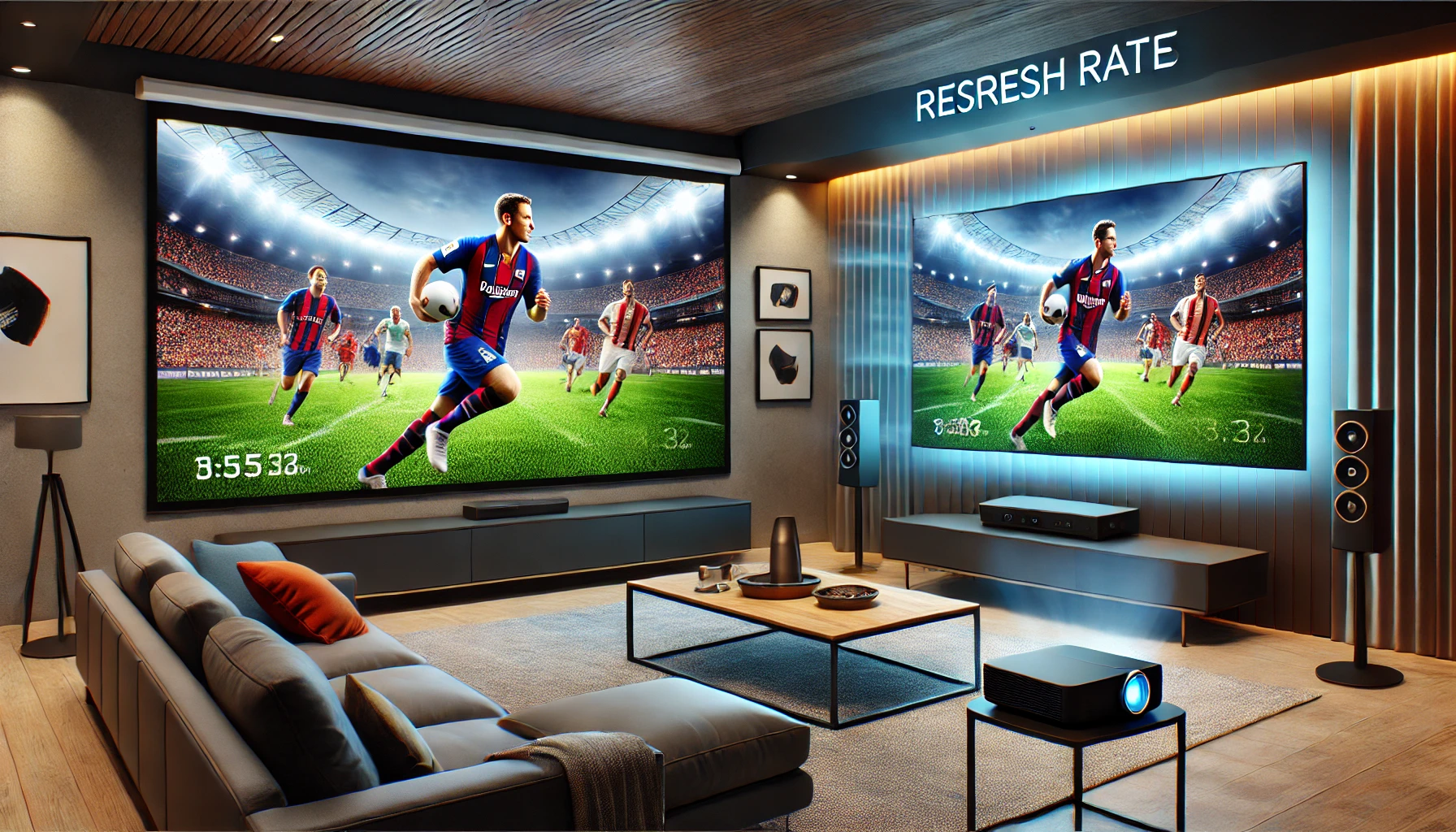Choosing the right TV size for your room hinges on several critical factors. First, accurately measure your room dimensions to determine viewing distances, which should ideally be 1.5 to 2.5 times the screen’s diagonal for HD TVs, and closer for 4K models. Consider popular sizes, like 55 inches for living rooms or 75+ inches for home theaters, while also factoring in your furniture arrangement and room layout. Aesthetic choices and lighting solutions can further enhance your viewing experience. To guarantee your selection meets future needs, examine technological features and budget considerations. Explore further insights on optimizing your TV choice for an extraordinary experience.
Key Takeaways
- Measure your room dimensions and viewing distances to determine the appropriate TV size for optimal comfort and picture clarity.
- For HD TVs, sit 1.5 to 2.5 times the screen size away; for 4K, 1 to 1.5 times the screen size is ideal.
- Common TV sizes include 32 inches for small spaces, 55 inches for living rooms, and 75+ inches for home theaters.
- Consider the room layout; rectangular rooms allow more flexible TV placement compared to square rooms, affecting viewing angles.
- Factor in lighting conditions; avoid glare by using curtains or blinds and ensure ambient lighting complements the TV’s brightness.
Measuring Your Room Dimensions
When selecting the ideal television size for your space, accurately measuring your room dimensions is essential. This initial step lays the groundwork for a seamless integration of your television into the room’s overall aesthetic and functionality. Begin by evaluating the room layout, taking note of the dimensions of the walls where the TV may be placed. Consider both the width and height to guarantee the television complements rather than overwhelms the space.
Next, assess the furniture arrangement. The proximity of seating to the television, along with the positioning of other furniture, will influence both the viewing experience and the ideal TV size. For instance, a larger screen may be suitable for a spacious area with a distance that allows for comfortable viewing, while a compact space may necessitate a smaller model to maintain a balanced look.
Additionally, consider the height at which the TV will be mounted or placed. This guarantees that it aligns with the viewer’s eye level, enhancing comfort and engagement. By meticulously measuring your room and understanding the furniture arrangement, you can confidently choose a television size that enhances your living space.
Understanding Viewing Distance

Understanding viewing distance is essential for maximizing your television experience, as it directly influences picture clarity and viewer comfort. Factors such as room size and screen size recommendations play significant roles in determining the ideal distance for best viewing. By carefully evaluating these elements, you can enhance not only your enjoyment but also the overall effectiveness of your home entertainment setup.
Optimal Viewing Distance
How far should you sit from your television to achieve the best viewing experience? Determining the ideal viewing distance is essential for enjoying your favorite shows and movies without straining your eyes. A general guideline for distance calculations is to sit at approximately 1.5 to 2.5 times the diagonal size of the screen. For instance, if you have a 55-inch TV, sitting between 6.5 to 11.5 feet away will provide an immersive experience.
In addition to distance, consider the viewing angles. An ideal setup guarantees that your line of sight aligns with the center of the screen. This positioning minimizes distortion and enhances color accuracy. For 4K Ultra HD TVs, the recommended distance reduces to about 1 to 1.5 times the screen size due to the increased pixel density, allowing for a closer viewing experience without loss of quality.
Ultimately, achieving ideal viewing involves personal preferences and room dynamics. Experiment with different distances while keeping these guidelines in mind to find your perfect spot. By prioritizing both distance calculations and viewing angles, you can elevate your home entertainment experience considerably.
Room Size Considerations
Typically, the size of your room plays a crucial role in determining the most suitable TV size and viewing distance. Understanding the dimensions of your space, including room shape, is essential for enhancing your viewing experience. A rectangular room, for instance, may allow for more flexibility in TV placement, while a square room might limit options and impact the viewing angles.
To achieve an immersive experience, consider the distance between your seating area and the TV. A general guideline suggests that the ideal viewing distance is approximately 1.5 to 2.5 times the diagonal size of the screen. However, the room shape can affect this; in narrower rooms, you may need to be more mindful of the viewing angles to avoid distortion or discomfort.
Additionally, the arrangement of your furniture can influence how many viewers can enjoy the screen simultaneously. Ensuring that the TV is positioned to accommodate optimal viewing angles for all seating arrangements will enhance the overall experience. By meticulously considering room size and shape, you can make informed decisions that lead to a more enjoyable and comfortable viewing environment.
Screen Size Recommendations
When selecting the appropriate screen size for your TV, it is vital to contemplate the viewing distance, as this determines not only the visual comfort but also the overall enjoyment of your viewing experience. The ideal viewing distance varies based on the resolution of the television; for instance, 4K UHD TVs allow for closer viewing compared to 1080p models. A general guideline suggests that viewers should sit at a distance of 1.5 to 2.5 times the diagonal size of the screen for peak screen clarity.
For example, if your TV measures 65 inches, the recommended viewing distance would range from approximately 8 to 13 feet. This distance guarantees that the viewer can appreciate the details without straining their eyes or compromising size perception. Sitting too close can lead to pixelation in lower-resolution content, while being too far may diminish the impact of larger screens.
Ultimately, understanding the interplay between screen size and viewing distance is pivotal. By aligning these factors, you can create an engaging and immersive viewing environment that maximizes both comfort and enjoyment.
TV Size Chart Guidelines
Understanding TV size chart guidelines is crucial for making an informed decision when selecting a television that suits your space and viewing habits. These guidelines provide a framework to determine the best screen size based on the distance from your seating area to the TV. As a general rule, the distance should be approximately 1.5 to 2.5 times the diagonal screen size for HD TVs, while 4K models can be viewed from closer distances, enhancing the viewing experience.
TV size trends have shifted towards larger screens, reflecting consumer preferences for immersive experiences. Consequently, it’s important to assess your room dimensions and layout to make an appropriate choice. Additionally, consider the impact of viewing angle adjustments; the ideal angle guarantees that all viewers enjoy a consistent and vibrant picture quality.
For instance, a larger screen may be tempting, but if the viewing angle is compromised, it can lead to a subpar experience. By following these TV size chart guidelines, you can confidently select a television that not only complements your room but also enhances your overall viewing pleasure.
Screen Resolution Considerations
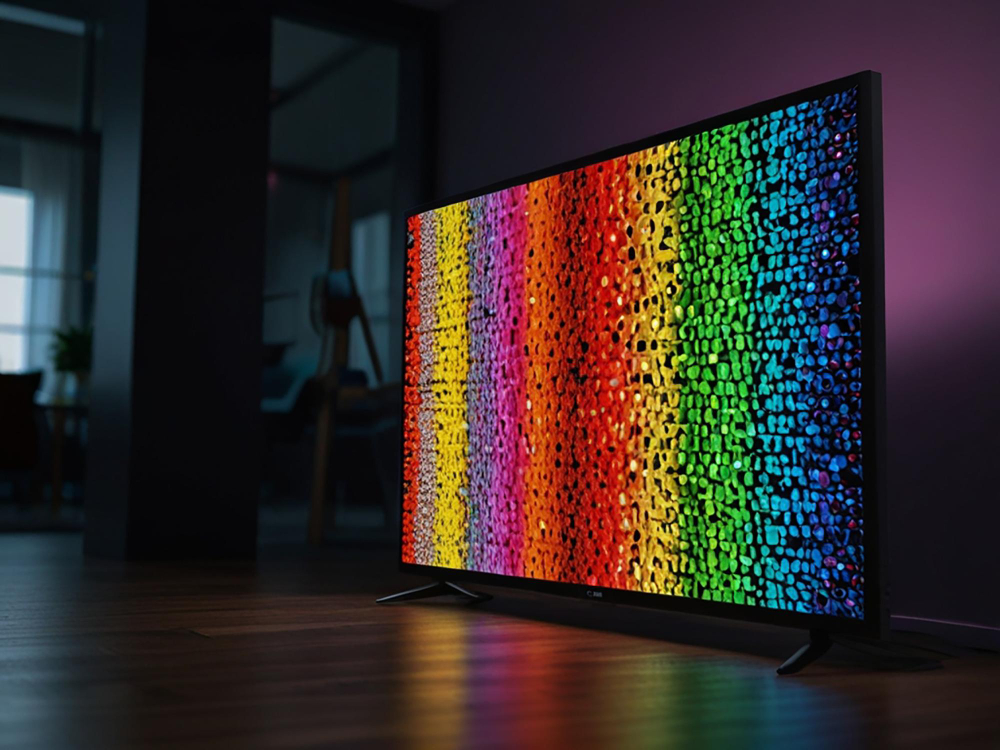
When selecting a television, screen resolution plays an essential role in determining overall viewing quality. The choice between 4K and 1080p can greatly impact your viewing experience, especially at various ideal distances. Understanding these differences will help you make an informed decision that aligns with your preferences and space constraints.
4K vs. 1080p
As consumers plunge into the world of television options, the debate between 4K and 1080p resolution often surfaces as a pivotal factor in their decision-making process. Understanding the nuances of these two resolutions is essential for selecting the most suitable television for your viewing experience.
4K resolution, also known as Ultra HD, boasts a pixel count of 3840 x 2160, delivering four times the detail of 1080p, which has a resolution of 1920 x 1080. This significant increase in pixel density results in sharper images, especially on larger screens, making the 4K benefits particularly evident when watching high-definition content. Additionally, 4K TVs often feature advanced upscaling technology, which enhances lower-resolution content, providing viewers with a more immersive experience.
In a 1080p comparison, while the resolution is still widely accepted and offers satisfactory quality for many viewing situations, it may fall short in providing the same level of detail and clarity as 4K. For those who prioritize future-proofing their entertainment setup and enjoy the latest in cinematic excellence, investing in a 4K television might be the most prudent choice.
Optimal Viewing Distance
Determining the ideal viewing distance for your television is essential for maximizing the visual experience, particularly as screen resolutions evolve. As we shift from 1080p to 4K and beyond, the best distance changes, allowing viewers to fully appreciate the enhanced clarity and detail. A well-calibrated distance not only heightens enjoyment but also greatly impacts viewing comfort and reduces the risk of eye strain.
To guarantee an immersive experience, consider the following factors:
- Resolution: Higher resolutions allow for closer viewing without sacrificing image quality.
- Screen Size: The larger the screen, the farther back you should sit to maintain visual clarity.
- Room Layout: Your room’s dimensions and furniture arrangement can affect how comfortably you can view the screen.
For 4K televisions, the recommended distance is typically 1 to 1.5 times the screen size (in inches). For a 65-inch TV, this translates to a viewing distance of 5.5 to 8 feet. Striking the right balance guarantees that your viewing experience is not only enjoyable but also healthy, preventing discomfort and fatigue during extended periods of watching.
Room Layout and Furniture Placement
Reflecting on the spatial dynamics of your living area is essential for optimizing your TV experience. The arrangement of furniture greatly influences both comfort and the overall aesthetics of the room. A well-thought-out furniture arrangement allows for seamless viewing while enhancing the room’s ambiance.
Here’s a helpful guide to keep in mind when planning your room layout:
| TV Size (inches) | Viewing Distance (feet) | Ideal Room Size (sq ft) |
|---|---|---|
| 32 | 4-6 | 100-150 |
| 43 | 6-8 | 150-200 |
| 55 | 7-9 | 200-250 |
| 65 | 8-10 | 250-300 |
| 75 | 10-12 | 300+ |
Ensure that your seating is arranged in a manner that allows for an unobstructed view of the screen. This not only minimizes neck strain but also enhances the viewing experience. Additionally, reflect on how your TV placement interacts with existing furniture to maintain a harmonious flow and cohesive room aesthetics. Balancing these elements can elevate both functionality and style in your living space.
Aspect Ratio and Its Importance
How does aspect ratio impact your viewing experience? The aspect ratio—defined as the relationship between the width and height of the screen—plays a vital role in how content is perceived. Different aspect ratio types, such as 16:9, 4:3, and 21:9, can greatly influence the viewing experience, affecting everything from immersion to visual clarity.
Consider the following emotional impacts of aspect ratio choices:
- Immersive storytelling: A wide aspect ratio can envelop viewers in cinematic experiences, enhancing emotional connection.
- Frustration with cropping: An incompatible ratio may lead to key visuals being cut off, diminishing the intended narrative.
- Aesthetic pleasure: A well-matched aspect ratio creates harmony between the content and the screen, elevating enjoyment.
The aspect ratio impact extends beyond technical specifications; it shapes how stories unfold on-screen. Choosing the right aspect ratio is essential for maximizing enjoyment and ensuring that the visual narrative remains intact. By understanding the importance of aspect ratios, viewers can make informed decisions that enhance their overall TV experience.
Types of TVs and Sizes Available
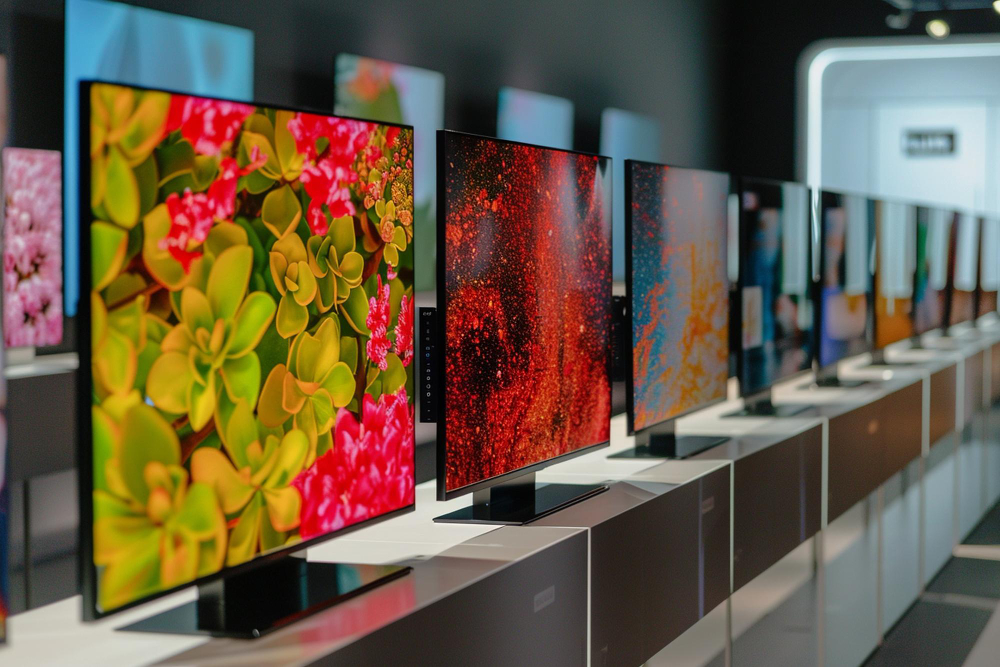
Understanding the various types of TVs and their available sizes is essential for making an informed purchasing decision. Common sizes range from compact models ideal for smaller spaces to large screens designed for immersive viewing experiences. Additionally, the type of display—such as LED, OLED, or QLED—can greatly impact picture quality and overall performance, further influencing your choice.
Common TV Sizes
When selecting a television, understanding the range of common TV sizes available is crucial for optimizing your viewing experience. The right size not only enhances visual enjoyment but also guarantees that your space is utilized effectively. With a variety of options, it’s important to take into account TV dimensions and how they relate to your room’s layout.
Common TV sizes typically include:
- 32 inches: Ideal for small spaces like bedrooms or kitchens, offering a cozy viewing experience.
- 55 inches: A popular choice for living rooms, providing an immersive experience without overwhelming the space.
- 75 inches and larger: Perfect for home theaters or expansive living areas, creating a cinematic atmosphere.
When making size comparisons, remember that the distance from your seating area can greatly impact viewing comfort. A larger screen can enhance detail and engagement, while a smaller screen may be preferable in confined settings. Ultimately, selecting the right TV size involves balancing your aesthetic preferences with practical considerations, making sure you enjoy every moment of your favorite shows and films.
Type of Displays
As technology continues to evolve, the landscape of television displays has expanded, offering a diverse array of options tailored to different preferences and needs. Among the most popular types are LED and OLED displays, each with unique characteristics. LED technology, known for its excellent energy efficiency, provides impressive display brightness, making it suitable for well-lit rooms. However, OLED displays stand out due to their advantages in color accuracy and contrast, as each pixel emits its light, resulting in deeper blacks and vibrant colors.
Refresh rates also play a significant role, particularly for gamers. A higher refresh rate enhances gaming performance, minimizing motion blur for fast-paced action. For viewers seeking an immersive experience, screen curvature can provide a wider field of view, enhancing the overall viewing experience.
Modern televisions have embraced smart features, allowing seamless integration with streaming services and home automation. Additionally, attention to audio quality has improved, with many models offering built-in sound systems that elevate the home cinema experience. Ultimately, understanding these display types and their capabilities will guide consumers in making informed choices for their specific needs and preferences.
Personal Viewing Preferences
Personal viewing preferences play an essential role in selecting the ideal TV size for your space. Understanding your individual viewing habits can greatly influence your satisfaction with your television experience. Factors such as the distance from the screen, the type of content you enjoy, and how often you watch can guide your decision.
Consider the following emotional aspects of your viewing preferences:
- Comfort: An appropriately sized TV enhances your viewing comfort, allowing for extended binge-watching sessions without strain.
- Engagement: The right size fosters a more immersive experience, drawing you into the story and enhancing emotional connections with characters.
- Social Interaction: A larger screen can transform movie nights into memorable gatherings, creating a shared experience that strengthens bonds.
When determining the perfect TV size, reflect on your personal preferences and how they align with your viewing habits. Whether you favor cinematic experiences, gaming, or casual background entertainment, tailoring your choice to your lifestyle guarantees that each viewing session is enjoyable and fulfilling. Remember, the right size is not just about dimensions; it’s about creating an environment that resonates with your unique viewing experience.
The Impact of Lighting
Although the size of your TV is vital, the impact of lighting in your viewing environment can greatly influence your overall experience. Proper lighting can enhance picture quality while also ensuring comfort during extended viewing sessions. Understanding various lighting sources in your room is important for maximizing your setup.
Natural light, for instance, can create glare on your screen, which detracts from the viewing experience. To counteract this, think about using curtains or blinds to control sunlight during peak hours. Additionally, strategically positioned lamps can minimize shadows and enhance the ambiance without overwhelming the screen’s brightness.
For best glare reduction, it’s advisable to use ambient lighting that complements the TV’s brightness. Dimmable LED lights can be particularly effective, allowing you to adjust the room’s illumination based on the content being viewed. Moreover, think about wall-mounted sconces or floor lamps that provide indirect lighting, which helps to soften contrasts and reduces eye strain.
Ultimately, achieving the right balance of lighting not only improves visual clarity but also transforms your viewing space into a more enjoyable environment, making it vital to think about lighting when selecting your TV size and placement.
Wall Mounting vs. Stand
The decision between wall mounting your TV or using a stand is an integral part of optimizing your viewing experience, especially after considering the impact of lighting in your space. Each option presents its own set of benefits and challenges. Wall mounting offers several mounting advantages, such as saving floor space, providing a clean aesthetic, and allowing for customizable viewing heights that can enhance your overall comfort.
On the other hand, a TV stand provides stability and can serve as additional storage for media devices and decor. It’s often easier to set up and allows for flexibility in rearranging your room layout. When weighing your options, consider the following emotional factors:
- A clutter-free environment that promotes relaxation and enjoyment
- Enhanced safety for children or pets, reducing the risk of tipping
- Personalized style that reflects your unique taste and home decor
Ultimately, the choice between wall mounting and a stand should align with your lifestyle, space constraints, and design preferences, ensuring that your TV enhances both your viewing pleasure and the aesthetic of your room.
Future-Proofing Your Purchase
When investing in a new television, future-proofing your purchase is essential to guarantee it remains relevant and functional as technology advances. As the landscape of home entertainment evolves, integrating future technologies into your TV choice can greatly enhance its longevity.
First, take into account a model that supports 4K and even 8K resolutions. As content becomes increasingly available in higher definitions, TVs with these capabilities will assure you can enjoy the latest offerings without needing an upgrade. Additionally, look for smart features that allow for seamless updates and access to popular streaming services. Modern TVs often come equipped with built-in apps and voice control capabilities, making them compatible with evolving smart home ecosystems.
Another aspect to keep in mind is connectivity. Make certain your TV has multiple HDMI ports, including HDMI 2.1, which supports enhanced audio and video features. Moreover, compatibility with emerging technologies such as HDR and variable refresh rates can greatly enhance your viewing experience.
Budget Considerations
Steering through the landscape of television purchases requires careful consideration of your budget, as it plays a pivotal role in determining the features and quality you can afford. With a myriad of options available, identifying budget-friendly options that meet your needs is crucial.
When evaluating your budget, consider the following emotional triggers that can influence your decision:
- The thrill of watching your favorite shows on a larger screen
- The satisfaction of finding a deal that doesn’t compromise on quality
- The joy of creating a home theater experience without breaking the bank
Investing in a television doesn’t have to be an overwhelming experience. By focusing on cost-effective choices, you can still enjoy a quality viewing experience while staying within your financial limits. Look for brands that offer competitive pricing and consider models that provide essential features without excessive frills. Additionally, exploring sales events or refurbished options can yield significant savings.
Ultimately, a well-defined budget not only guides your purchase but also guarantees that you can enjoy your new television without financial strain, paving the way for countless hours of entertainment.
Frequently Asked Questions
How Do I Choose Between OLED and LED for My TV?
When deciding between OLED and LED, consider OLED benefits like superior contrast and vibrant colors, while LED advantages include brightness, energy efficiency, and affordability. Assess personal viewing preferences to determine the best fit for your needs.
What Are the Best Brands for Reliability and Quality?
For reliability and quality, consider prominent players: Samsung’s stellar reliability, LG’s legendary quality, Sony’s steadfast durability, Vizio’s vibrant performance, TCL’s tempting affordability, and Panasonic’s prestigious reputation—all contribute uniquely to the television landscape.
Can I Use My TV for Gaming and Streaming Simultaneously?
Yes, you can use your TV for gaming and streaming simultaneously. However, make certain your television supports high refresh rates to maintain peak gaming performance while providing excellent streaming quality for an enhanced viewing experience.
How Can I Improve Audio Quality With My TV Setup?
To improve audio quality in your TV setup, consider audio enhancement solutions such as soundbar options, which provide superior sound performance. Additionally, guarantee proper placement and connectivity to optimize sound delivery and overall listening experience.
Should I Consider a Curved Screen for My Room?
When evaluating a curved screen, consider the benefits such as enhanced immersion and wider viewing angles. However, be mindful of drawbacks, including potential glare issues and limited ideal seating positions, which may impact overall viewing experience.
Conclusion
In conclusion, selecting the appropriate television size necessitates a multifaceted approach involving spatial measurements, viewing distance, and room dynamics. By considering these elements alongside screen resolution and lighting conditions, one crafts an ideal viewing experience that harmonizes with the environment. Additionally, contemplating future technological advancements and budget constraints guarantees a prudent investment. Ultimately, the ideal television acts as both a portal to immersive experiences and a seamless extension of the living space, enhancing the aesthetic and functional qualities of the room.



